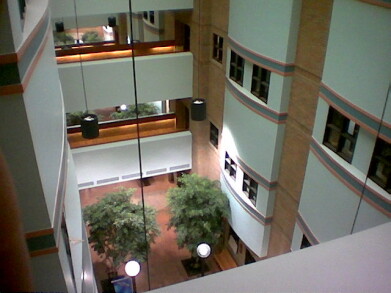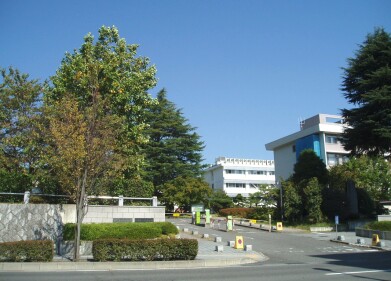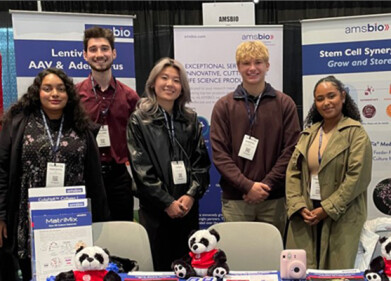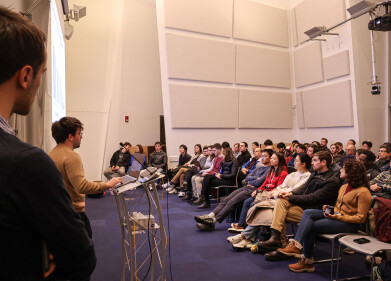-
 The atrium of University of Michigan's Department of Electrical Engineering and Computer Science. Photo: Courtesy of https://www.flickr.com/photos/dokas/
The atrium of University of Michigan's Department of Electrical Engineering and Computer Science. Photo: Courtesy of https://www.flickr.com/photos/dokas/
Research News
University of Michigan photonic team seeks $50 million centre-level funding
Jan 06 2025
Programme seeks to bring accuracy of laboratory quantum measurement to applications with real-world devices
A University of Michigan-led team is one contender among a dozen research consortiums bidding for a $50 million centre which aims to build quantum technologies that are robust enough for real world applications.
University of Michigan (U-M)has received initial funding in the first phase of the National Science Foundation’s (NSF) Quantum Science and Technology Demonstrations programme, with a $1 million grant set to be used to explore options to develop in its field of research, across the coming year.
The team, whose project is called Quantum Photonic Integration and Deployment ─ QuPID ─ aims to build the first chips that harness the incredible precision of light for real-world measurements in the field with quantum semiconductors. Working with leading industrial partners, the researchers will develop quantum systems that can perform the high-accuracy measurements.
“We’re essentially trying to build quantum gadgets and demonstrate their performance so that they can be integrated into other user’s devices. Whether that’s AI, measuring the purity of a liquid, or predicting major storms up to months in advance,” said Mackillo Kira, U-M professor of electrical engineering and computer science and the principal investigator on the project.
The team is targeting applications such as ultrasensitive environmental monitoring, GPS-free navigation, ultrasensitive semiconductor chip quality control and detailed geological mapping of underground structures from the air or satellites.
“Transforming the quantum advantage demonstrated in labs to serve widespread applications in the real world comes down to simplifying and packaging the instrumentation needed to manipulate and measure the properties of light,” said Parag Deotare, U-M associate professor of electrical engineering and computer science and deputy project director.
ILM WEBINAR SERIES 2025 – BOOK NOW
The centre will explore creative approaches to achieve a robust quantum system that remains agnostic to the applications. In addition, we will create design kits that can be used by researchers and industries, globally, to adapt for specific applications.”
In the first phase of this competitive initiative, the team will explore new applications and materials, to build on previous advances. Breakthroughs have included identifying previously undetectable radio signals via quantum sensing, discovering new particle-like elements within quantum materials using quantum light, and switching quantum information at speeds millions of times faster than existing computers.
They have also developed a groundbreaking material: ferroelectric nitrides that can store electric fields.
“No other material has shown such promise as an all-in-one quantum-integration solution,” said Zetian Mi, U-M professor of electrical engineering and computer science and a co-principal investigator.
Ferroelectric nitrides could both produce and detect quantum entangled light, maintain internal quantum states, and convert light across a broad range of wavelengths without losses ─ all within a single chip. These versatile materials are also compatible with today’s silicon-based microelectronics, paving the way for deployment in a laboratory-to-chip transition.
The principal and co-principal investigators represent all three components of new technology development: theory, materials research and device integration. Kira’s area is quantum theory, while Mi grows quantum materials atom by atom. Deotare and Jelena Vučković, professor of electrical engineering at Stanford University, build quantum photonic devices, and Zheshen Zhang, associate professor of electrical engineering and computer science at U-M, brings expertise in quantum sensing.
Beyond the team’s leaders, the QuPID group also includes researchers from Ohio State University, Harvard University, Michigan State University, the University of Arizona and the University of Southern California.
Industry researchers will participate from Honeywell, MONSTR Sense Technologies, TOPTICA Photonics, INTEL, KPIT, MITRE, Quantum Opus and Raytheon. The Air Force Research Laboratory and NASA Glenn Research Centre are also represented, as well as international collaborators from the University of Regensburg, Germany and Canada’s Polytechnique Montréal.
By the end of 2025, the team will submit a proposal laying out how they would pursue their most promising applications. If successful, they will be awarded a further $4 million over two years to make progress toward demonstrating the technology in the lab ─ eight teams are expected to receive initial funding. After that, the NSF has budgeted for six teams to build their real-world-ready quantum devices, supported by up to $50 million over five years.
The team will rely on the Lurie Nanofabrication Facility, the Michigan Centre for Materials Characterization and individual faculty labs to produce and study quantum materials.
Digital Edition
Lab Asia 31.6 Dec 2024
December 2024
Chromatography Articles - Sustainable chromatography: Embracing software for greener methods Mass Spectrometry & Spectroscopy Articles - Solving industry challenges for phosphorus containi...
View all digital editions
Events
Jan 22 2025 Tokyo, Japan
Jan 22 2025 Birmingham, UK
Jan 25 2025 San Diego, CA, USA
Jan 27 2025 Dubai, UAE
Jan 29 2025 Tokyo, Japan


















